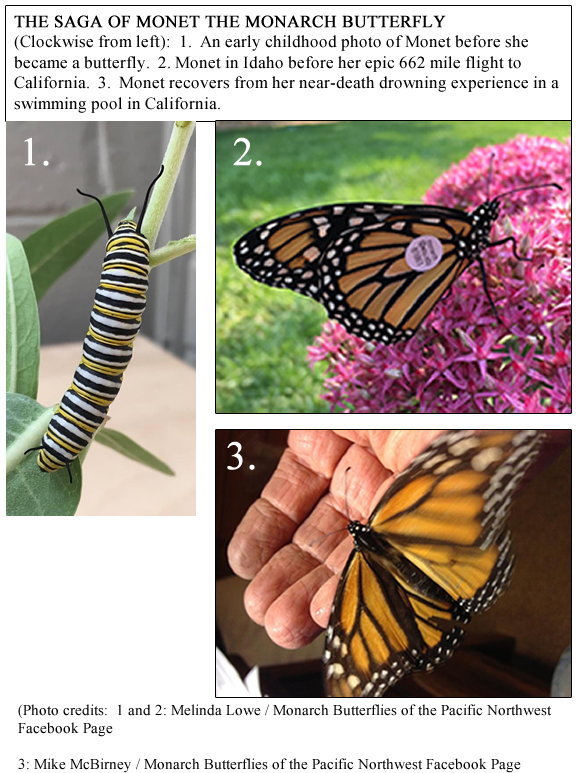Many are aware that Monarch butterflies from the
western United States are known to migrate
hundreds of miles to spend the winters in warmer
areas along the coast, in the Southwest United
States, and in Mexico.
A Monarch butterfly reared in southern Idaho’s
Treasure Valley made history when it was rescued
from a swimming pool by a California homeowner.
This monarch butterfly (Danaus plexippus) had
flown all the way from Idaho to overwinter along
the California Coast.
Biologists studying the movements of monarchs
documented a first for the declining species
March 2 in the swimming pool of a California
resident who welcomed the Idaho visitor’s
historic landing. The homeowner found the
butterfly a few hundred yards from a known
overwintering site where the female butterfly
likely spent the winter. While monarchs west of
the Rocky Mountains are typically regarded as
belonging to the western population, this is the
first documented case of a tagged Idaho monarch
making the journey to California since
Washington State University began a tagging
program in 2012.
Reared in Idaho by a monarch butterfly
enthusiast, B1861, affectionately known as
Monet, departed Idaho in September. She flew
approximately 662 miles southwest on a skyward
journey across Nevada and into southern
California before settling in the greater Santa
Barbara area, an overwintering site for many
monarch butterflies of the western population.
The homeowner rescued and then released the
butterfly, which apparently was none the worse
for her near-death-by-drowning experience.
(Story continues below these photographs)

“This is big news. Monet is the first Idaho
monarch in my study to be recovered in
California, and at six months of age she is the
longest-lived monarch documented in this
Washington State University tagging effort,”
said Dr. David G. James, an associate professor
at WSU specializing in invertebrate
conservation. “Monet will go down in Idaho
monarch history, that’s for sure.”
Monet was the name that Melinda Lowe bestowed on
the caterpillar she began rearing August 14,
2017 in her Idaho home.
“I had a specially-built butterfly cage
constructed for her where she grew fat and happy
eating freshly-picked showy milkweed leaves,”
said Lowe.
Fast forward a few weeks and Monet emerged from
her chrysalis and became a California-bound
butterfly that Lowe released that evening.
“She immediately flew up and out of the yard and
toward the west. I flapped my hand waving
goodbye. Such a bittersweet moment,” Lowe said.
Six months later, Dr. James informed Lowe that
Monet had turned up in a swimming pool more than
600 miles away.
“Hopefully, she is now heading inland from
Goleta, California, with dry wings seeking
milkweed to lay her eggs,” said Dr. James.
The monarch butterfly is a national priority
species for the Fish and Wildlife Service, and
community-based projects in Idaho’s Treasure
Valley and throughout the country are helping to
enhance and restore habitat to benefit the
monarch. This beautiful orange and black species
is known for its remarkable annual,
multi-generational migration between its
over-wintering grounds in central Mexico and
California, to its spring and summer breeding
grounds in the northern and interior portions of
the United States and Canada. This butterfly
requires milkweed plants to reproduce, and
female monarchs will only lay eggs on milkweeds.
Native milkweeds are the primary food sources
for monarch caterpillars.
Monarch butterflies and other pollinators are in
trouble. The decline of these species may be
attributed to habitat fragmentation, urban and
agricultural development, pesticide use and lack
of nectar plants for food. In the case of the
migratory monarch, the lack of native milkweed
is believed to be a critical limiting factor.
The Service is working with our partners to help
increase monarch populations by working with
agricultural producers, transportation agencies,
government agencies, and the public to create
wildlife-friendly pollinator gardens and
essential milkweed habitat for monarchs. Learn
more about our efforts to save the monarch at
https://www.fws.gov/savethemonarch/ |

